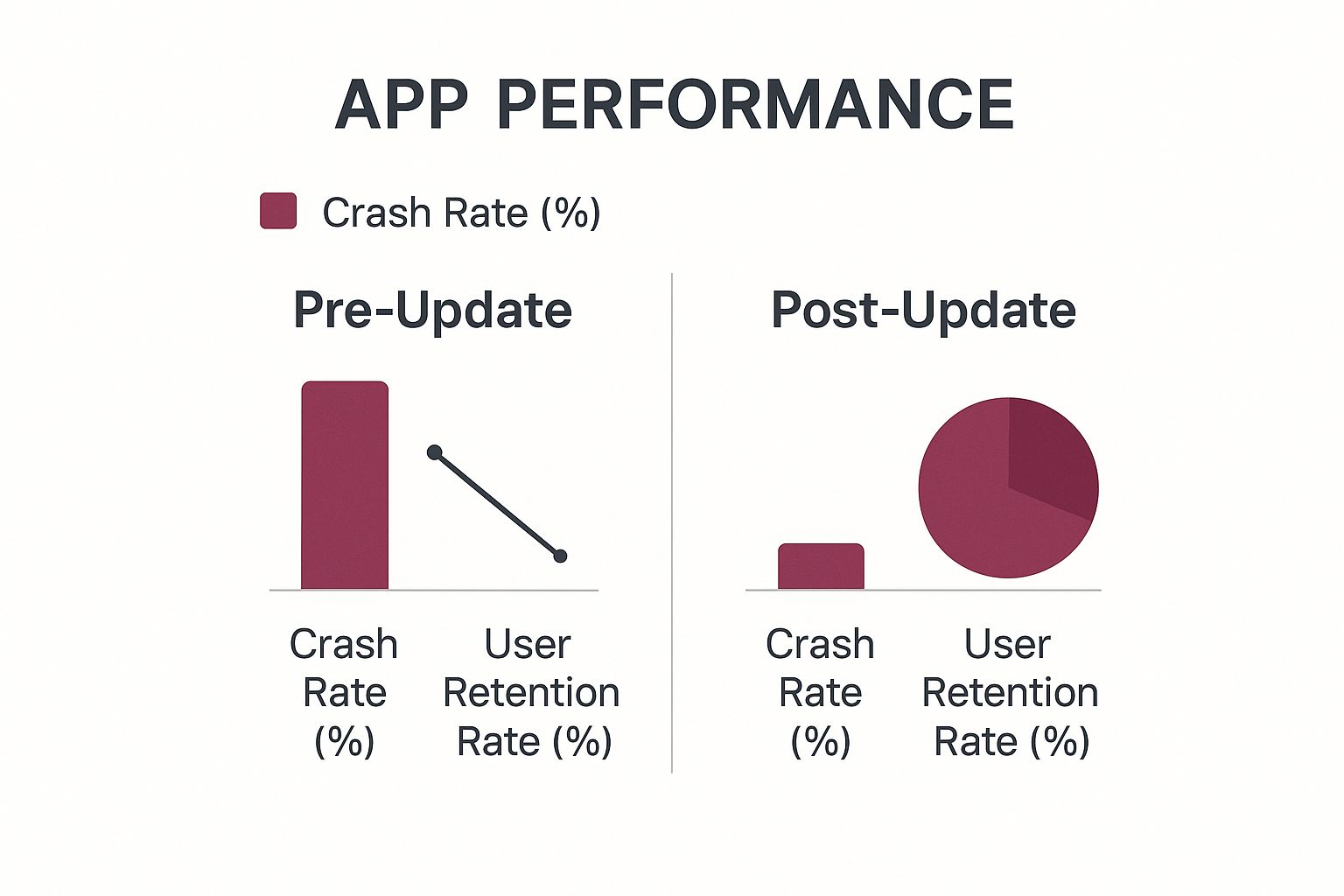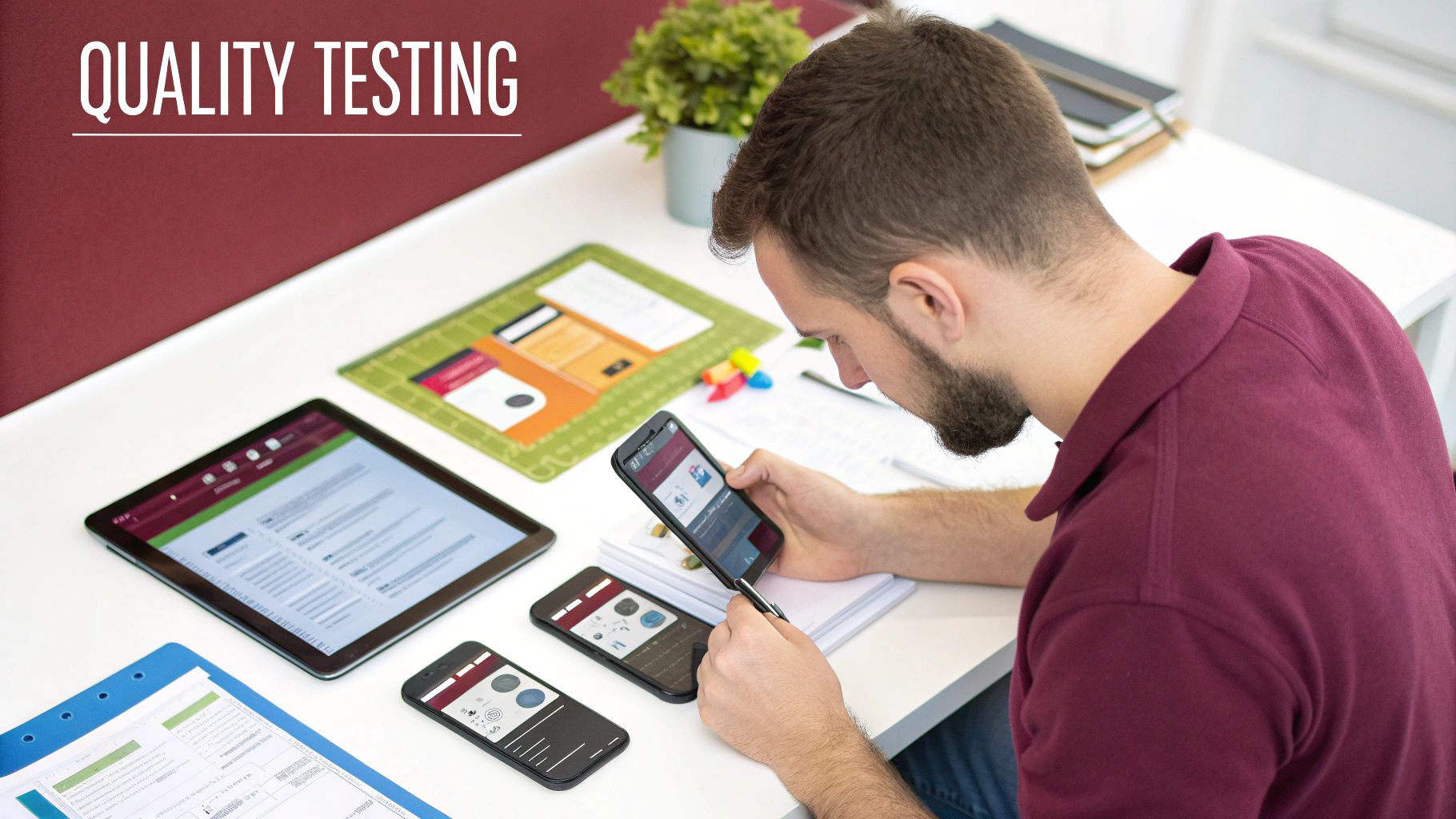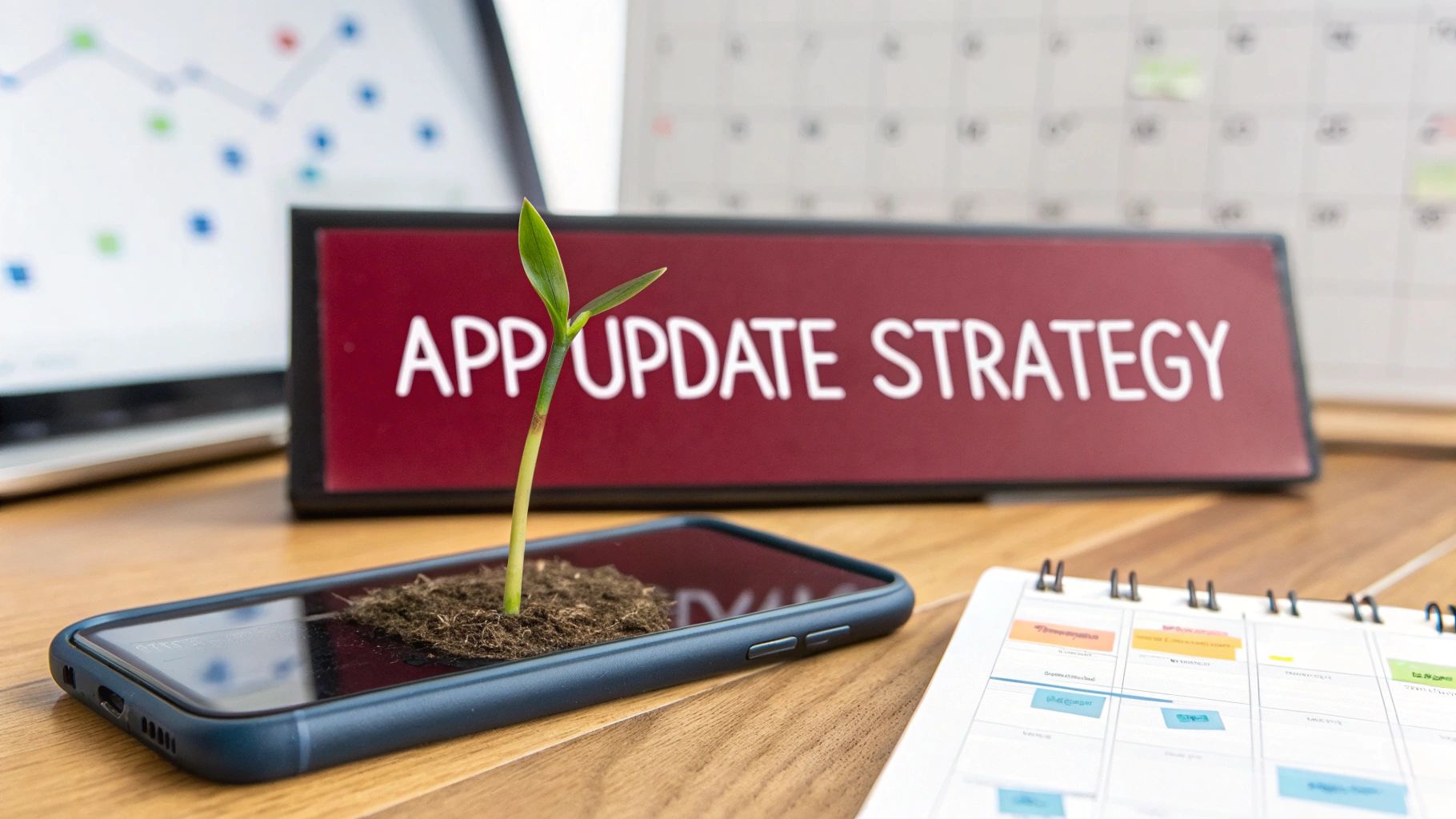Why Your Mobile App Update Strategy Makes or Breaks Success
Think of your mobile app like a well-loved car. Regular maintenance keeps it running smoothly, while ignoring those little creaks and groans can lead to major problems down the road. Similarly, neglecting your app updates can drive users away, sending them straight to your competitors.
A common pitfall for developers is building features they find exciting, rather than focusing on what users actually need. It’s like adding a turbocharger to your car when what you really need are new tires. It’s cool, sure, but doesn’t address the core issue. This disconnect between developers and users can lead to updates that miss the mark, frustrating users and hindering app growth.
This user-centric approach is crucial in today’s competitive mobile app market. To understand just how much the market is growing, take a look at these projections:
To understand the scope of this market growth, let’s take a look at some key figures:
Mobile App Market Growth Projections Key statistics showing the expanding mobile app market and download trends
| Metric | 2023 | 2025 Projection | Growth Rate |
|---|---|---|---|
| Global App Downloads (Billions) | 257 | 299 | 16.34% |
These figures, sourced from Tekrevol, highlight the explosive growth in the mobile app market. This growth means competition is fierce, and users have high expectations. A solid update strategy is essential for survival.
The Evolution of Mobile App Updates
The mobile landscape has drastically changed. Remember when software updates were a yearly event? Now, we see weekly, or even daily, micro-improvements. This shift reflects changing user expectations. Users expect constant refinement and are quick to abandon apps that feel stale. It’s like expecting your car’s navigation system to always have the latest maps.
Your update strategy must be agile and responsive. Think small, consistent improvements – like regular oil changes for your app – that keep everything running smoothly.
The Hidden Costs of Neglect
Both over-updating and under-updating can have consequences. Over-updating can lead to “update fatigue,” overwhelming users with constant notifications. Imagine your car reminding you to check the tire pressure every five minutes – annoying, right? Conversely, neglecting updates can make your app feel outdated and buggy. It’s like skipping those oil changes and risking engine trouble. Finding the right update cadence is key.
Real-World Examples and Transformations
Many apps have seen incredible transformations by prioritizing user feedback in their update strategies. For example, a language-learning app significantly increased daily active users after implementing a system for user-suggested vocabulary. By listening to their users, they delivered valuable improvements. Check out this article on App Engagement Metrics to learn more. These real-world examples show how a user-centric approach can drive growth and engagement. It’s not just about what you update, but how and when you do it.
Building Your Update Strategy From the Ground Up
Imagine planning a cross-country road trip. You wouldn’t just hop in the car and start driving, would you? You’d map out your route, identify key stops, and plan for potential detours. A successful mobile app update strategy requires the same level of foresight. Instead of relying on gut feelings, savvy developers map the user journey to understand behavior patterns and anticipate needs.
This means understanding not just what users are doing in your app, but when they’re doing it. Knowing peak activity times and preferred features allows you to prioritize updates that truly resonate with your audience. Just like choosing the most scenic route for your road trip, you’re crafting an update experience that keeps users engaged and satisfied.
Balancing User Needs and Development Capacity
Creating a robust update strategy also means finding a balance between user demands and developer capacity. Think of it like a chef juggling multiple orders in a busy restaurant kitchen. There are feature requests, bug fixes, performance enhancements—all vying for attention. Prioritization is key. You can’t do everything at once, so you need a system for managing competing priorities without overwhelming your team or confusing your users.
This balancing act is visualized in the infographic below:

As the infographic illustrates, focusing on key areas like crash rates and user retention has a direct impact on post-update performance. By strategically addressing these factors, you can significantly improve the user experience and create a more successful app.
Setting Realistic Update Cadences
Just as different vehicles require different maintenance schedules, different app categories demand unique update approaches. A gaming app, with its focus on fresh content, might thrive on frequent updates. On the other hand, a productivity app prioritizes stability and might benefit from a less frequent, more measured cadence.
Update frequency plays a crucial role in user engagement. Data shows that around 35% of the top 1000 Android apps are updated weekly, meaning 346 of these apps receive at least one update per week. Discover more insights on update frequency and its impact. This highlights the need to align your update schedule with both user expectations and your development team’s capacity. Pushing updates too frequently can overwhelm users and strain resources, while infrequent updates can lead to stagnation.
To illustrate this further, let’s look at some typical update frequencies across various app categories:
Update Frequency Strategies by App Category
| App Category | Recommended Frequency | Primary Focus | User Impact |
|---|---|---|---|
| Gaming | Weekly/Bi-Weekly | New Content/Features | High Engagement, Potential Churn if poorly executed |
| Social Networking | Weekly | Bug Fixes/New Features | Maintains engagement, addresses user feedback |
| Productivity | Monthly | Stability/Performance | Minimizes disruption, focuses on reliability |
| E-commerce | Bi-Weekly | Performance/Promotions | Optimizes sales, improves user experience |
| Utility | As Needed | Bug Fixes/Security | Ensures functionality, maintains trust |
As you can see, finding the right balance between delivering value and maintaining stability is key.
Recognizing Warning Signs
Finally, every good road trip has a plan B. Similarly, a strong update strategy includes mechanisms for recognizing when things aren’t going as planned. Think of these as the warning lights on your car’s dashboard. Declining user engagement, negative reviews, and increasing uninstall rates are all red flags that demand attention.
By actively monitoring key metrics and user feedback, you can address potential issues proactively. Just like a regular check-up can prevent major car trouble down the road, consistent monitoring helps keep your app running smoothly and ensures a positive user experience.
Mastering Platform-Specific Update Approaches

Crafting a winning mobile app update strategy starts with a simple truth: iOS and Android users are different. Their habits, their expectations, even the phones in their pockets shape how they interact with your app. Ignoring these differences—a surprisingly common mistake—can mean missing out on opportunities to boost engagement and keep users coming back.
Tailoring Your Strategy to iOS
Think of Apple’s app ecosystem like a well-tended garden. Updates undergo a strict review process, requiring careful planning and flawless execution from developers. This walled-garden approach, while sometimes a source of frustration, contributes to the stability and overall quality users associate with iOS apps. It’s like dining at a top-tier restaurant: you anticipate a certain level of polish and consistency. This meticulous process, coupled with the loyalty many users feel toward Apple products, helps explain why iOS apps often see better retention.
Leveraging Android’s Flexibility
The Android world, on the other hand, is more like a vibrant street market. Google Play’s instant deployment lets developers move fast, pushing updates and fixes quickly. This agility allows for a more experimental approach, making it easier to A/B test features and react to user feedback. It’s like running a food truck: you can quickly adjust the menu based on what customers want. However, this speed demands careful monitoring and a solid rollback plan in case things go sideways.
Bridging the Retention Gap
Interestingly, the data reveals a real difference in user retention between the two platforms. After 30 days, iOS apps retain roughly double the users of their Android counterparts. iOS holds onto an average of 4.1% of users, while Android retains just 2.1%. This gap highlights the need for tailored mobile app update strategies. Discover more insights. Android developers can use techniques like well-timed updates, personalized content, and in-app messages to close this gap and build stronger user loyalty. For example, syncing updates with peak usage times or highlighting new features with targeted notifications can dramatically increase engagement and encourage continued use.
Managing Cross-Platform Releases
Successfully managing updates across both platforms takes careful coordination. Imagine conducting an orchestra: every instrument section (platform) needs to play in harmony for a beautiful symphony (seamless user experience). Practical strategies include maintaining separate code branches for platform-specific features, using platform-specific A/B testing tools, and optimizing your update descriptions for each app store’s algorithm. For more tips on making this smoother, check out our guide on automatic app updates. By understanding the nuances of each platform and planning strategically, developers can deliver a unified update experience that resonates with both iOS and Android users while maximizing the strengths of each ecosystem.
Modern Deployment Tools That Change Everything
Remember the old days of mobile app updates? Submitting to the app store, biting your nails during the approval process, and then crossing your fingers that no major bugs slipped through? Modern deployment tools like CodePushGo have flipped the script, giving developers the ability to push quick fixes and roll out features gradually. It’s all about keeping users engaged and happy while taking the edge off those traditional update risks.
Over-the-Air Updates: A New Era of Agility
Top-tier development teams know that the fastest path to happy users doesn’t always go through the app store. Over-the-air (OTA) updates let developers bypass the usual deployment bottlenecks, delivering critical bug fixes and performance boosts straight to users’ devices. Think of it like a Formula 1 pit crew: they can tune your car while it’s still racing, maintaining peak performance without a pit stop.
This screenshot from CodePushPlus shows their intuitive dashboard. Developers can manage and monitor deployments in real time, with key info like active versions, deployment progress, and user engagement metrics readily available. This lets teams react quickly to any emerging issues. It’s like having a finger on the pulse of your app, empowering you to respond to user feedback and ensure a smooth update experience.
Implementing a Continuous Deployment Strategy
Continuous deployment, powered by tools like CodePushGo, enables a more iterative and responsive mobile app update strategy. You can release smaller updates more frequently, gathering feedback and tweaking things along the way. This is incredibly valuable in the fast-moving mobile world, where user expectations change by the day. For example, exploring blue-green deployment strategies can minimize downtime and risk during these updates.
Here’s how successful teams use continuous deployment:
-
Segmented Rollouts: Imagine testing a new cake recipe on a few friends before making it for a big party. Segmented rollouts are similar – you release to a small group of users first. This lets you gather feedback and spot any issues before they impact everyone.
-
Real-time Monitoring: Keep a close eye on update adoption rates and watch for unexpected behavior. This real-time insight lets you react quickly, rolling back any problematic releases before they spread too far. Think of it as an early warning system.
-
Swift Rollbacks: Picture the “quick save” feature in a video game. If things go south, you can quickly jump back to a safe point. A robust rollback mechanism does the same for your app: if an update causes problems, you can instantly revert to the previous version, minimizing disruption for your users.
Balancing Speed and Compliance
OTA updates bring great speed and flexibility, but it’s important to stay within app store guidelines. Some updates, like major feature releases or changes to core functionality, still need app store approval. Understanding these rules is crucial for a good relationship with app stores and a smooth experience for your users. By using OTA updates strategically for smaller fixes and improvements, you can reserve app store submissions for bigger changes. This helps streamline your workflow and keep your users happy.
Tracking What Actually Matters for Update Success

Numbers can be deceiving. Think of download counts and star ratings as the shiny cover of a book – they might attract attention, but they don’t tell the whole story. Relying solely on these vanity metrics can lead you astray. A truly successful mobile app update strategy depends on understanding the metrics that reflect real user satisfaction and drive meaningful growth. It’s about looking beyond the surface and diving into the data that reveals how users actually interact with your app after an update.
Moving Beyond Vanity Metrics
Imagine a retail store. You wouldn’t just want people to walk in; you’d want them to browse, engage with the products, and ultimately make a purchase. Similarly, with your app, you want users to truly use it – exploring its features and finding value. That’s engagement depth, and it’s a much better indicator of an update’s success than simple download numbers.
Also, releasing new features isn’t enough. You need to know if people are actually using them. That’s where feature adoption rates come into play. High adoption suggests your updates resonate with users. Low adoption? It might be time to rethink your design or onboarding process. Data-driven insights are key to refining your strategy.
Finally, for apps with a revenue model, consider the revenue impact. Are your updates boosting in-app purchases, subscriptions, or ad revenue? Understanding the financial implications is crucial for prioritizing future development and aligning your update strategy with your business goals.
A/B Testing and User Feedback
A/B testing isn’t just for marketing; it’s a powerful tool for optimizing your updates. Imagine presenting different versions of a dish to a focus group to get their feedback. A/B testing works similarly, allowing you to compare how different segments of your user base react to variations of your update. This lets you refine your approach based on actual user behavior, not just guesswork.
User feedback is also essential. Don’t just collect it – analyze it! Look for patterns and trends. A few negative reviews might be outliers, but a consistent stream of complaints about a specific feature signifies a real problem. Proactively addressing such issues can prevent them from snowballing into major setbacks.
Case Studies and Actionable Insights
Learning from others is invaluable. Explore how successful apps have leveraged data to improve their update strategies. Did they focus on performance improvements to enhance user retention? Did they implement better tutorials to increase feature adoption? Studying these real-world examples can provide practical guidance for your own approach. By using actionable templates and dashboards to track the metrics that truly matter, you can turn data into informed decisions and propel your app towards success.
Navigating Security and Compliance Without Slowing Down

Building a robust mobile app update strategy isn’t just about adding exciting new features. It’s also about fostering and maintaining user trust. This means security and compliance should be baked into your update process from the start, not tacked on as an afterthought.
Many developers have unfortunately experienced this firsthand: ignoring security and compliance can completely derail even the most carefully crafted updates. Imagine constructing a magnificent building only to discover it doesn’t meet building codes. A costly oversight, easily preventable with a little foresight.
Regulatory Shifts and Their Impact
The world of regulations is in constant motion. New privacy laws, security standards, and other compliance requirements appear regularly, impacting how you collect, store, and manage user data.
These shifts can substantially alter your mobile app update strategy, requiring adjustments to your planning process and potentially even core app functionality. Think of it like navigating a bustling city with constantly changing traffic patterns. You need to remain adaptable and adjust your route to reach your destination efficiently.
For example, the introduction of GDPR and iOS privacy updates forced many apps to completely rethink how they handled user data. These changes went beyond simple technical tweaks. They demanded clear, understandable communication with users, explaining the updates and rebuilding trust. This transparency is essential for maintaining a positive user experience and avoiding negative reactions.
Balancing Speed and Security
One of the trickiest parts of managing mobile app updates is finding the right balance between rapid iteration and rigorous security testing. You want to get updates out quickly to keep users engaged, but rushing through security checks can create vulnerabilities. It’s like speeding in a car—you get there faster, but at a much higher risk.
Here are some practical approaches to help you maintain this balance:
-
Automated Security Testing: Integrate automated security testing into your CI/CD pipeline to catch potential issues early in development. Think of this as your regular car maintenance check, preventing problems before they arise.
-
Phased Rollouts: Release updates to a smaller group of users first. This gives you a chance to identify and fix any bugs or security issues before they affect a larger audience. It’s like a test drive before a big road trip.
-
Penetration Testing: Simulate real-world attacks to find any weaknesses in your app’s security. Think of this as a stress test for your app’s defenses. You might be interested in: mobile app encryption best practices.
Communicating Privacy Changes Effectively
When updates involve changes to privacy policies or data handling, communicating clearly with your users is crucial. Avoid technical jargon and explain things simply, focusing on the benefits for the user. Imagine you’re explaining a medical procedure to a patient. Clear, straightforward language builds trust and allays anxieties.
Honesty and transparency are your best tools for maintaining user confidence and avoiding negative perceptions. By building compliance considerations into your workflow from the beginning, you avoid last-minute scrambles and ensure a smoother, more secure update process. This proactive approach not only protects your users but also safeguards your app’s reputation and ensures its long-term success.
Your Mobile App Update Strategy Action Plan
Let’s turn our discussion about mobile app update strategies into a concrete plan you can put into action right now. This isn’t just theory; it’s a practical guide with actionable steps, realistic timelines, and clear goals. Each action item comes with specific criteria for success, potential roadblocks to watch out for, and practical tips for overcoming those challenges. Whether you’re managing one app or a whole portfolio, you’ll find frameworks and tools that work for your team and your users.
Creating Your Personalized Roadmap
This section gives you the resources you need to create a successful update strategy:
-
Downloadable Templates: Think of these pre-built update planning templates as blueprints for your project. They provide a structure for outlining your goals, identifying your target audience, and prioritizing important features.
-
Realistic Implementation Schedules: We’ll show you how to build schedules that take real-world limitations into account—no more overly optimistic timelines that set you up for disappointment. This is about practical planning, not wishful thinking. You might find this helpful: CI/CD Pipeline Tutorial.
-
Key Performance Indicators (KPIs): Track the metrics that matter from the very beginning. We’ll help you measure update effectiveness, concentrating on user engagement, feature adoption, and the impact on revenue (if relevant). This data-driven method ensures your updates deliver real value.
Building Adaptability Into Your Strategy
The mobile world is always evolving. User preferences shift, market conditions change, and new technologies appear all the time. Your update strategy must be flexible enough to adapt to these changes without needing a complete redesign every time something new happens.
Imagine steering a ship through changing currents. You need to adjust your course as needed without losing sight of your destination. We’ll explore frameworks for:
-
Monitoring User Feedback: Pay close attention to what your users are telling you. Analyze reviews, support tickets, and in-app feedback. These real-time insights help you identify emerging needs and adjust your update priorities accordingly.
-
Analyzing Market Trends: Observe the competitive landscape. What are other apps doing? What new features are gaining popularity? Understanding market trends helps you anticipate user expectations and stay ahead of the game.
-
Experimenting With New Technologies: Don’t be afraid to explore and try new things. A/B test different update methods, try out new deployment tools, and experiment with different communication strategies. This iterative approach helps you discover what works best for your specific app and users.
By incorporating these elements, you’ll build a mobile app update strategy that’s not only effective now but also adaptable for the future. This translates to continuous improvement, greater user satisfaction, and long-term success for your app.
Ready to build a robust and flexible update strategy? CodePushGo streamlines your over-the-air (OTA) updates for React Native apps, allowing you to release bug fixes, new features, and patches in minutes. Visit CodePushGo to learn more and start optimizing your update process.




